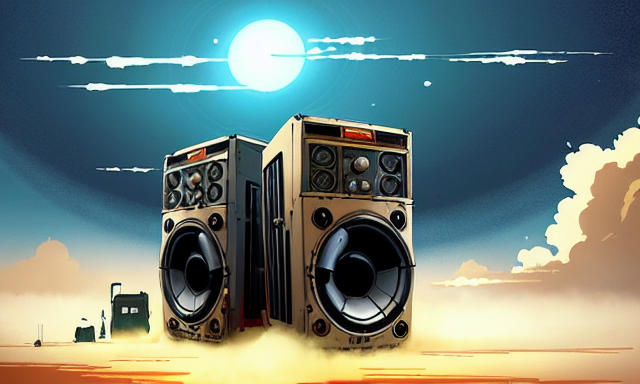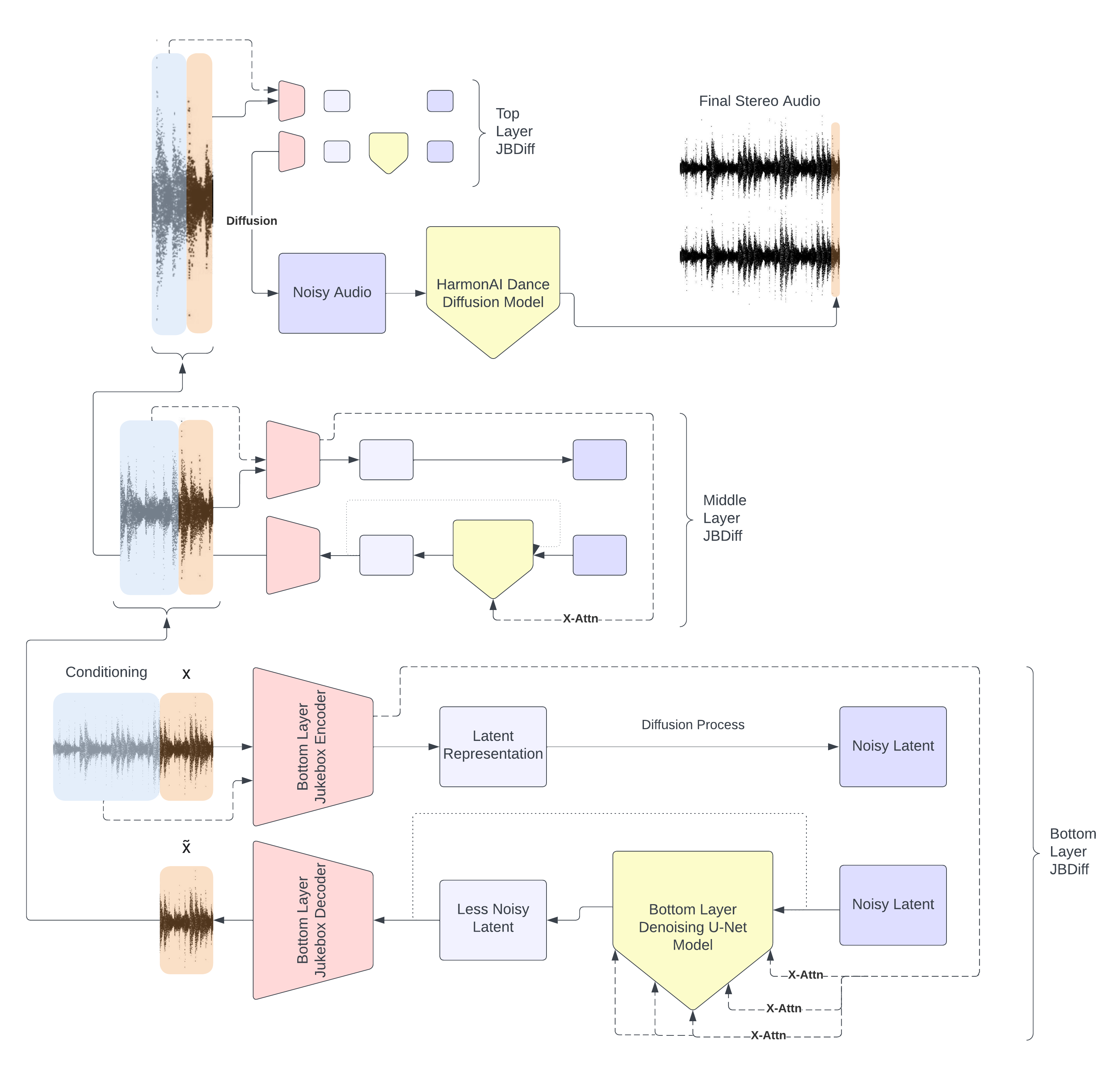Jukebox Diffusion relies heavily on work produced by OpenAI (Jukebox) and HarmonAI (Dance Diffusion), also big thanks to Flavio Schneider for his work creating the audio-diffusion repo I used for diffusion models
At its core Jukebox Diffusion is a hierarchical latent diffusion model. JBDiff uses the encoder & decoder layers of a Jukebox model to travel between audio space and multiple differently compressed latent spaces. At each of the three latent levels a Denoising U-Net Model is trained to iteratively denoise a normally distributed variable to sample vectors representing compressed audio. The final layer of JBDiff is a Dance Diffusion Denoising U-Net model, providing a bump in audio quality and transforming the mono output of Jukebox into final stereo audio.
Read more on Medium
Examples can be heard here
I recommend setting up and starting a virtual environment (use Python 3):
virtualenv --python=python3 venv
source venv/bin/activate
Clone repo:
git clone https://github.com/jmoso13/jukebox-diffusion.git
Install it:
pip install -e jukebox-diffusion
Navigate into directory:
cd jukebox-diffusion
Install requirements:
pip install -r requirements.txt
Download model checkpoints:
python download_ckpts.py
That's it! You're set up. Maybe useful to check and see your GPU settings:
nvidia-smi
All music for context and init audio is expected to be in 44.1 kHz wav format for Jukebox Diffusion
Examples:
# Train deepest level JBDiff on personal music library
python train.py --train-data ./wavs --jb-level 2 --ckpt-save-location ./ckpts
# Resume training middle layer of JBDiff from checkpoint
python train.py --train-data ./wavs --jb-level 1 --ckpt-save-location ./ckpts --resume-network-pkl ./ckpts/ckpt1.ckpt
Explanation of args:
usage: train.py [-h] --train-data DIR --jb-level JB_LEVEL --ckpt-save-location FILE [--log-to-wandb BOOL] [--resume-network-pkl FILE] [--num-workers NUM_WORKERS]
[--demo-every DEMO_EVERY] [--num-demos NUM_DEMOS] [--demo-seconds DEMO_SECONDS] [--demo-steps DEMO_STEPS] [--embedding-weight EMBEDDING_WEIGHT]
[--ckpt-every CKPT_EVERY] [--project-name PROJECT_NAME]
Train JB Latent Diffusion Model on custom dataset
optional arguments:
-h, --help show this help message and exit
--train-data DIR Location of training data, MAKE SURE all files are .wav format and the same sample rate
--jb-level JB_LEVEL Which level of Jukebox VQ-VAE to train on (start with 2 and work back to 0)
--ckpt-save-location FILE
Location to save network checkpoints
--log-to-wandb BOOL T/F whether to log to weights and biases
--resume-network-pkl FILE
Location of network pkl to resume training from
--num-workers NUM_WORKERS
Number of workers dataloader should use, depends on machine, if you get a message about workers being a bottleneck, adjust to recommended
size here
--demo-every DEMO_EVERY
Number of training steps per demo
--num-demos NUM_DEMOS
Batch size of demos, must be <= batch_size of training
--demo-seconds DEMO_SECONDS
Length of each demo in seconds
--demo-steps DEMO_STEPS
Number of diffusion steps in demo
--embedding-weight EMBEDDING_WEIGHT
Conditioning embedding weight for demos
--ckpt-every CKPT_EVERY
Number of training steps per checkpoint
--project-name PROJECT_NAME
Name of project
Examples:
# Sample for 30s using all levels with no init audio conditioned on song_a.wav, save results to a directory called results/
python sample.py --seconds-length 30 --context-audio song_a.wav --save-dir results --project-name jbdiff_fun --levels 012
# Sample for length of init audio song_b.wav using song_a.wav as context, use only levels 2 & 1 and use token-multiplier of 4, both of these will speed up generation, also change the dd-noise-style to 'walk'
python sample.py --init-audio song_b.wav --init-strength 0.15 --context-audio song_a.wav --save-dir results --project-name jbdiff_fun --levels 12 --dd-noise-style walk --token-multiplier 4
Explanation of args:
usage: sample.py [-h] [--seconds-length SECONDS_LENGTH] [--init-audio FILE] [--init-strength INIT_STRENGTH] --context-audio FILE --save-dir SAVE_DIR
[--levels LEVELS] [--project-name PROJECT_NAME] [--noise-seed NOISE_SEED] [--noise-style NOISE_STYLE] [--dd-noise-seed DD_NOISE_SEED]
[--dd-noise-style DD_NOISE_STYLE] [--noise-step-size NOISE_STEP_SIZE] [--dd-noise-step-size DD_NOISE_STEP_SIZE]
[--token-multiplier TOKEN_MULTIPLIER] [--use-dd USE_DD] [--update-lowest-context UPDATE_LOWEST_CONTEXT]
Sample from JBDiffusion
optional arguments:
-h, --help show this help message and exit
--seconds-length SECONDS_LENGTH
Length in seconds of sampled audio
--init-audio FILE Optionally provide location of init audio to alter using diffusion
--init-strength INIT_STRENGTH
The init strength alters the range of time conditioned steps used to diffuse init audio, float between 0-1, 1==return original image,
0==diffuse from noise
--context-audio FILE Provide the location of context audio
--save-dir SAVE_DIR Name of directory for saved files
--levels LEVELS Levels to use for upsampling
--project-name PROJECT_NAME
Name of project
--noise-seed NOISE_SEED
Random seed to use for sampling base layer of Jukebox Diffusion
--noise-style NOISE_STYLE
How the random noise for generating base layer of Jukebox Diffusion progresses: random, constant, region, walk
--dd-noise-seed DD_NOISE_SEED
Random seed to use for sampling Dance Diffusion
--dd-noise-style DD_NOISE_STYLE
How the random noise for generating in Dance Diffusion progresses: random, constant, region, walk
--noise-step-size NOISE_STEP_SIZE
How far to wander around init noise, should be between 0-1, if set to 0 will act like constant noise, if set to 1 will act like random noise
--dd-noise-step-size DD_NOISE_STEP_SIZE
How far to wander around init DD noise, should be between 0-1, if set to 0 will act like constant noise, if set to 1 will act like random
noise
--token-multiplier TOKEN_MULTIPLIER
Multiplier for base_tokens
--use-dd USE_DD whether or not to use dd
--update-lowest-context UPDATE_LOWEST_CONTEXT
whether or not to update lowest context
This yaml file has some extra parameters to tweak:
sampling:
diffusion:
dd:
num_steps: 150
init_strength: 0.15
ckpt_loc: "./epoch=2125-step=218000.ckpt"
xfade_samples: 1536
xfade_style: "constant-power"
0:
num_steps: 20
embedding_strength: 1.3
init_strength: 0.5
ckpt_loc: "./epoch=543-step=705000.ckpt"
1:
num_steps: 70
embedding_strength: 2.0
init_strength: 0.67
ckpt_loc: "./epoch=1404-step=455000.ckpt"
2:
num_steps: 250
embedding_strength: 4.0
ckpt_loc: "./epoch=4938-step=400000_vqvae_add.ckpt"
Each section refers to a level in the JBDiff architecture. 2 is the lowest level/highest compression. 0 is the highest level before Dance Diffusion model. dd level refers to the Dance Diffusion level
num_steps: number of steps to take in the diffusion process for this level
embedding_strength: weight for context in cross-attention reasonable values are 0-10
init_strength: strength of lower level init at current level
ckpt_loc: string location of level checkpoint
xfade_samples: number of samples for crossfade on the dd level
xfade_style: can be either 'linear' or 'constant-power'
Have fun!

